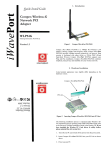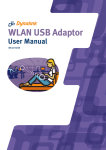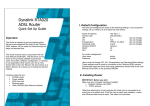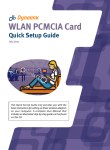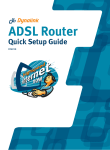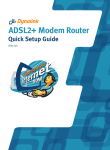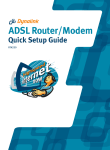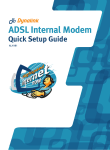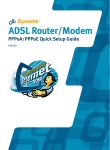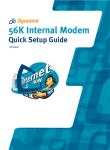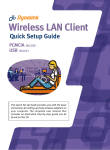Download WLG25PCI QSG
Transcript
WLAN PCI Adaptor Quick Setup Guide WLG25PCI This Quick Set-Up Guide provides you with the basic instructions for setting up the wireless adaptor on your computer. The complete User Manual that includes an illustrated step-by-step guide can be found on the provided CD. 1 Introduction A Wireless Local Area Network (WLAN) serves the same purposes as a conventional wired Ethernet network (LAN) but only without the wires. Computers are linked together by radio waves. The wireless adaptor is your “wireless network card”. It turns your computer into a wireless station, allowing it to connect to other wireless stations or wireless access points to share network resources including Internet access. THIS PRODUCT CAN BE SET UP ON TWO TYPES OF WIRELESS NETWORKS 1. Infrastructure network In an infrastructure network, your wireless adaptor connects your computer to a wired network via a wireless access point. This enables your computer to share all available resources including Internet access and peripherals on the wired network. 2. Ad-hoc (peer to peer) network This is a computer network consists of wireless stations. Your wireless adaptor connects your computer to other wireless stations for file sharing. WIRELESS PRIVACY Privacy is an important issue with wireless. These functions are provided for access control and security: 1. Service Set ID (SSID) SSID is the wireless network domain name. You must set your wireless adaptor to the SSID of the wireless network you wish to join. This is similar to a network login name. Certain access points provide basic protection by hiding the SSID. You are expected to enter the correct SSID before joining the network. 2. Wired Equivalent Privacy (WEP) is an authentication algorithm that protects users from eavesdropping. When enabled, all wireless stations transmit data encrypted using a predetermined key. The receiving station will use the same key for decryption. It is recommended that WEP is only used for backward compatibility with legacy equipment. 3. Advanced security WPA (Wi-Fi Protected Access) and 802.1x These are more robust security mechanisms than WEP. Both WPA and 802.1x require a separate RADIUS server for authentication. But home users generally do not have access to RADIUS servers. A “special home mode” of WPA known as WPA-PSK can be used. This allows users to manually enter a password, known as Pre-Shared Key or PSK to connect. WLAN PCI Adaptor Quick Set-up Guide 2 Two encryption systems are available with WPA-PSK. The TKIP (Temporal Key Integrity Protocol) is an enhanced version of WEP. The encryption key is changed for every packet. Compared with WEP, TKIP makes it very difficult for hackers to decrypt messages. Another system, AES (Advanced Encryption Standard) was developed for the US Government. AES is seen by many as the best compromise among requirements for security, performance and flexibility. Installing the Wireless Adaptor Before You Start: If you have installed the Wireless Adaptor driver & utility before, please uninstall this before reinstalling. Refer to Section 6.1 of this Guide. INSTALL PROCEDURE FOR HARDWARE Switch off the computer. Open the computer chassis to locate an empty PCI slot. Touch the exposed metal chassis of the computer to discharge any electrostatics. Firmly insert the card into the PCI slot. Secure the card to the chassis using a screw. Replace the cover. Connect the supplied antenna to the card. INSTALL PROCEDURE FOR DRIVER AND WIRELESS CONFIGURATION UTILITY 1. Power on the computer. 2. Windows would pop up a “Found New Hardware” message box, requesting search for a driver. Click Cancel to proceed. 3. Exit from all programs that may be running in the background. 4. If you are reading this Quick Set-Up Guide from the supplied CD, return to the previous menu and click the Driver & Utility button. Otherwise, load the supplied CD and go the WLG25PCI product page and click the Driver & Utility button. 5. Double click on RaLink2_RT2500.exe to run the install wizard. 6. Click Easy Install to begin installing driver and utility. 7. When Setup has finished installing, click Finish to complete. 8. Windows will detect new hardware and start to install the driver. Windows XP users – if installation pauses, click the Continue Anyway button to resume driver installation. 9. If asked to select your location country, click on the drop down box to select Australia or New Zealand. 10.Click Finish when the completion screen appears. 11. Depending on your operating system, Windows may ask to restart. 3 Connecting to a wireless network 3.1 WINDOWS XP USERS ONLY Windows XP comes with a built in Zero Configuration Utility for wireless configuration and monitoring. You may use either the Vendor’s RaConfig utility or the Windows XP default utility. It is important to use only one utility. The Vendor’s RaConfig utility allows you to switch control between the two utilities. It is recommended that you use the Vendor’s RaConfig utility. By default the Windows XP Zero Configuration Utility is active. To use the Vendor’s RaConfig utility, right click the RaConfig icon on taskbar, select Use RaConfig as Configuration Utility. From this point on, you only need to use the vendor’s utility. The icon of the Windows Zero Configuration Utility will remain on the taskbar. 3.2 FOR ALL USERS 1. From the Windows taskbar, double click on the Vendor’s RaConfig Utility icon. 2. The screen starts with Site Survey. After the initial search, a list of available access points is shown. The first access point uses WPA-PSK authentication & TKIP encryption. The second access point uses WEP. The third access point does not use any form of encryption. The last access point hides its SSID and uses no encryption. Any of these may also use MAC address filtering for restricting access (refer to section 5). WLAN PCI Adaptor Quick Set-up Guide 3. Highlight the access point you wish to joint, click Connect. 4. If the network uses encryption, you will be asked to enter the key. Obtain the key from the system administrator and enter into the WPA Preshared Key box. Click OK. 5. The wireless adaptor will attempt to connect. If authentication has been successful, the Site Survey page shows Connected status, and the Link Status page starts reporting the link quality: This confirms your computer has joined the wireless network. If you wish, the parameters you entered can be saved to a profile. Click the Add to Profile button in the Site Survey page to store the parameters. Multiple profiles can be saved and modified at any time. If you want to join a network whose connection profile is already stored, select it from the Profile page and Activate. The wireless adaptor will automatically connect using the stored parameters. 3.3 ZERO CONFIGURATION UTILITY – WINDOWS XP ONLY If you prefer using the Windows Zero Configuration Utility, check that the Vendor’s utility is disabled. Right click the Vendor’s utility icon on taskbar, select Use RaConfig as Configuration Utility. From this point on, you only need to use the Windows default utility. Double click the icon. Windows will scan and list all available access points. Caution - access points with hidden SSID are not shown. Double click the access point you wish to join. If the network uses encryption, a network key is required. Obtain the key from the system administrator and enter into the box. The wireless adaptor will attempt to connect. If authentication has been successful, Windows will confirm the Connected status: WLAN PCI Adaptor Quick Set-up Guide 4 Other network settings 4.1 WEP If the network you wish to join is WEP enabled, you will have to configure for WEP. The WEP setting is already determined on the network by the network administrator. Before you start you should have obtained: 1. 2. 3. 4. The type of encryption, 64 or 128-bit. The encryption keys. The key number to be used. Open or shared key authentication. The settings must be identical to those entered into the access point. From the Site Survey page of the RaConfig utility, highlight the access point you wish to joint and click Connect. You will be asked to enter the WEP key: Click OK and the wireless adaptor will attempt to connect. 4.2 NETWORK WITH HIDDEN SSID 5 If the wireless network you wish to join does not broadcast its SSID, you will be asked to supply the SSID. If the SSID entered does not match the one in use, it is up to the access point to decline or accept the connection request. Adding extra security by MAC address filtering Some access points may use this option to provide an extra level of security. The MAC address, or the unique hardware ID of your wireless adaptor is pre-registered with the access point. If the network uses this function, you must supply the MAC address of your adaptor to the network administrator for inclusion into the access point. The MAC address of your adaptor is printed on a barcode label affixed to the product. Refer to Question 2 of the Troubleshooting section if you cannot locate the MAC address of your adaptor. 6 Uninstalling the adaptor, driver and utility 6.1 PERMANENT REMOVAL The correct procedure is to uninstall the software first. You will then be advised to physically remove the adaptor. To uninstall: 1. Close all programs that are currently running. 2. Click the Windows Start button, point to All Programs > RaLink > RT2500 and select Uninstall. 3. Follow the on screen instructions to proceed with software removal. 6.2 TEMPORARY REMOVAL WITHOUT UNINSTALLING DRIVER AND SOFTWARE It is recommended that you follow the standard Windows procedure for removing a device from your computer. 1. Double click the Safely Remove Hardware icon on taskbar. 2. Select the device you want to remove, click Stop and then OK. 3. Wait for the safe to remove message is displayed, click OK and remove device. 7 Troubleshooting 1. Cannot connect to access point (infrastructure mode) or other wireless stations (ad-hoc mode) Check that the correct install procedure was followed and the wireless utility displays the network you wish to join. Make sure the adaptor and access points/wireless stations are using the same SSID. If MAC address filtering (section 5) is enabled at the access point, contact the network administrator to include your adaptor’s MAC address into the list of authorised clients. If encryption is used, make sure the encryption parameters entered match the access point. Contact the network administrator if you are unsure. Restart computer. 2. How to find the MAC addresses of my adaptor The MAC address of your adaptor can be read off from a barcode label affixed on the product. WLAN PCI Adaptor Quick Set-up Guide If the adaptor is already installed, click Start > Run. Enter cmd and click OK. In the DOS window, type in ipconfig /all. Under Ethernet Adapter Wireless Network Connection, the MAC address is displayed as physical address in a group of 6 double digits. For Windows 98 or ME, click Start > Run, type in winipcfg and then OK. Select the wireless adaptor. Read off the MAC address from Adapter Address. 3. Poor Link Quality If the link quality is poor, it may be due to one of these reasons: Radio interference. Distance between adaptor and access point/wireless station is too far. Adjust the position of the antenna at the back of the computer. There are usually 13 channels available to use. In infrastructure mode, the access point selects the channel used for communications. In adhoc mode, the users can agree on picking a different channel to avoid radio interference. 4. How to avoid radio interference Other wireless devices and appliances on site may share the same 2.4 GHz band. If undesirable effects are observed, try using a different channel if possible. Also try the following: Move the computer to a different location or orientation. If adaptor is USB, move the adaptor instead of computer. If the radio interference source is known, increase the separation between the computer and the device causing the interference. Do not share the same AC power socket between the computer and the device generating the interference. Stay away from microwave sources (including microwave oven) and large metal objects. Warranty Dynalink warrants this product against defects in materials and workmanship for a period of twelve months from the original date of purchase. We will, at our discretion, repair or replace the faulty unit, free of charge, provided it is returned to us with proof of purchase from an authorised dealer within the warranty period. Return delivery after repair will be paid for by Dynalink. We reserve the right not to repair or replace goods that: have been mishandled, abused or not installed according to the guidelines as outlined in the instructions. have been subjected to a power surge from other equipment or other external factors. have been altered or modified. Help Always check that your hardware is installed correctly. Check our web site for the latest information and troubleshooting guide. If you have difficulties, contact Dynalink Technical Support for issues relating to installation and operation. If possible, visit Dynalink's on-line support area at: New Zealand www.dynalink.co.nz/support Australia www.dynalink.com.au/support Contact Dynalink’s Technical Support: New Zealand Australia Phone 0800 653 962 Phone 1800 653 962 Fax 0800 503 962 Fax 1800 063 962 (Monday-Friday: 8:30am-7:30pm) (Monday-Friday: 8:30am-5:30pm) WLG25PCI- QG1










